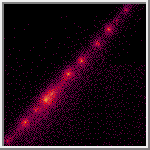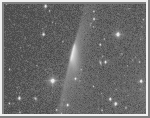
Table of Contents
- Comet Shoemaker-Levy 9 (This Page)
- Shoemaker-Levy 9 Impact
- Shoemaker-Levy 9 Image Index
- Hubble Press Release on the SL-9 Collision Results
- Comet Tutorial
Links to other Comet Shoemaker-Levy Home Pages
- Comet Shoemaker-Levy 9 Impact from JPL
- Effelsberg Radio Observations of the Great Comet Crash
- Comet Shoemake-Levy 9 page from SEDS
Comet Shoemaker-Levy 9 was the ninth short-periodic comet discovered by Eugene and Carolyn Shoemaker and David Levy. It was first detected on a photograph taken on the night of March 24, 1993, with the 0.4-meter Schmidt telescope on Palomar Mountain in California. The magnitude of the comet's brightness was reported as 14, more than a thousand times too faint to be seen with the naked eye. The existence of this object was soon confirmed by James V. Scotti of the Spacewatch program at the University of Arizona.
Through the observations and efforts of Brian G. Marsden and other astronomers, the comet's orbit was demonstrated to be around Jupiter and that it had made a very close approach to Jupiter on July 7, 1992. During this close approach, the unequal Jupiter gravitational attractions on the comet's near and far sides broke the fragile object apart. On March 27, an image was taken with the 2.2-m telescope on Mauna Kea in Hawaii that showed as many as 17 separate sub-nuclei strung out like pearls on a string 50 arc seconds long. An early image taken by Scotti on March 30 is shown below.

Early Shoemaker/Levy 9 Image
On July 1, 1993 an image was taken with the Hubble Space Telescope (HST) that clearly shows at least 15 individual fragments in one image frame of the train.

Early HST Image
Since it was not at all obvious where the center of mass of this new comet lay, most observers were using the position of what appeared to be the center of the train. This made an accurate orbit (or orbits) difficult to determine; however, after numerous observations of the comet, astronmers determined that the comet had passed within 96,000 kilometers (60,000 miles) of the center of Jupiter or 25,000 kilometers (16,000 miles) from the cloud tops during the July 8, 1992, approach. They also determined that it would again pass within 25,000 kilometers (16,000 miles) of the center of Jupiter, on July 19, 1994. This distance was less than the radius of Jupiter. In other words, the comet, or at least parts of it, could very well hit Jupiter.
Shoemaker-Levy 9 had been in a rapidly changing orbit around Jupiter for some time before this, probably for at least several decades. It did not fragment during earlier approaches to Jupiter because these were made at much greater distances than the 1992 approach. The comet's previous approaches to Jupiter probably came no closer than 9 million kilometers (5.6 million miles).
By December 9 1993, the probability of impact for all the large fragments of Shoemaker-Levy 9 was calculated to be greater than 99.99%. The fragments would hit over a period of several days, centered on July 19, on the night side of Jupiter. Unfortunately, this was the back side of Jupiter as viewed from Earth. The impact site would be close to the limb of Jupiter, near 75° from the midnight meridian and only a few degrees beyond the dark limb as seen from Earth.
The disruption of a comet into multiple fragments is an unusual event, the capture of a comet into an orbit about Jupiter is even more unusual, and the collision of a large comet with a planet is an extraordinary, millennial event.
 HST 1993 Mosaic
HST 1993 Mosaic
This high resolution image is a mosaic of images taken by the Hubble
Telescope on January 24-27, 1994. Twenty nuclei are visible with one
slightly outside of the field-of-view (to the right). Each
nucleus has its own coma and tail. The fourth nucleus from the
left (the first bright one) is apparently starting to separate
into at least two pieces.
(Courtesy NASA/JPL)
 HST Images
HST Images
These images were taken with the Hubble telescope's new camera's on
January 24-27, 1994. In the upper image, 20 nuclei are visible with one
slightly outside of the field-of-view (to the right). Each
nucleus has its own coma and tail. The fourth nucleus from the
left (the first bright one) is apparently starting to separate
into at least two pieces. The width and height of this image
project to distances of 605,000 kilometers (376,000 miles) and
126,500 kilometers (78,600 miles), respectively, at the comet.
The lower left and right parts of the screen show the region near the
brightest nucleus at higher resolution. To the left is the new image
from the corrected camera, while the image to the right shows old data
from the aberrated camera.
(Courtesy NASA/JPL)
 Depictions of the Shoemaker-Levy 9 Collision
Depictions of the Shoemaker-Levy 9 Collision
In this series of depictions, comet Shoemaker-Levy 9 impacting
Jupiter is shown from three different perspectives: at left,
from the viewpoint of Earth; center, from the Voyager 2
spacecraft in the outer reaches of the solar system; and, at
right, from Jupiter's south pole. For visual appeal, most of the
large cometary fragments are shown close to one another in this
image. At the time of Jupiter impact, the fragments will be
separated from one another by several times the distances shown.
(Courtesy NASA/JPL)

 Comet
Comet Halley's Comet
Halley's Comet Shoemaker-Levy 9 Impact
Shoemaker-Levy 9 Impact